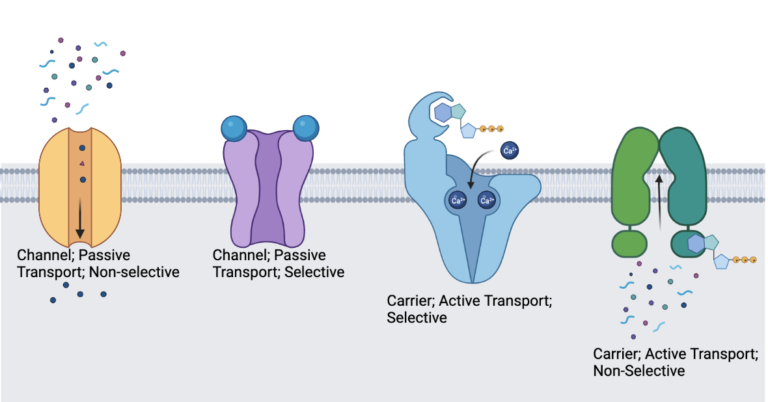Transporter proteins are just that: transporters. They are found in the membranes of cells, either in the cell membrane surrounding the full cell environment or in the membranes of organelles such as the mitochondria. Transport proteins are responsible for facilitating the entrance and exit of all compounds and small molecules that the cell needs to perform essential functions. Think of the cell as one big house, and each of the organelles as rooms in the house. If you want to enter the house, you need to use a door that passes through the wall, sometimes using a key to enter. This is similar to how a transporter protein allows passage of small molecules: it can recognize the substance and allow passage either due to a concentration gradient, receptor recognition, or just the natural flow of substances.
Channels and Carriers
Transporter proteins are divided into two major categories: channels and carriers. Channel proteins are open at both ends at all times, allowing passage both into and out of the cell or compartment. Carrier proteins are more selective in their passage, with only one opening in one direction at a time to direct the flow of molecules either into or out of the cell. Both channel and carrier transporter proteins come in different types, with different “keys” or methods of recognizing and allowing passage of small molecules.
Passive and Active Transport
There are two types of physical movement that allow small molecules to move across a cell’s membrane. The first is known as passive diffusion. This process refers to the passage of small molecules across a membrane without the use of any energy to move them. This can be achieved by small molecules that are hydrophobic, meaning they don’t like to be in water, and so they are drawn to the high lipid environment of the membrane that is also hydrophobic because like dissolves like. Passive diffusion also takes the form of small molecules passing from an area of high concentration to lower concentration to reach an equilibrium concentration. This is facilitated by a channel transport protein, open at both ends and allowing small molecules to travel along this concentration gradient.
In nature, molecules take up space in a solution in a matter that evenly distributes them. If there is a barrier to be crossed, the molecule will travel to the area where it is less dense to evenly distribute itself. This creates a concentration gradient, and molecules and ions travel from high concentration to low concentration spontaneously through protein channels in the cell membrane. This is a similar process to osmosis, in which water molecules move across a membrane to dilute salt or other molecules in solution and maintain an equivalent environment. You may be familiar with the process when you soak a sponge in water and it gets bigger and heavier: the water is traveling to the area in which there is less water molecules to maintain equality.
It is possible to move small molecules and ions that do not have a concentration gradient but are considered necessary for cell survival. This requires the use of energy in a process known as active diffusion. Active diffusion proteins usually make use of the chemical energy released during a reaction to draw in or expel out materials. Often, they recognize the molecule or ion in need of transport, bind to a molecule that undergoes a chemical reaction, allow passage through the membrane, and then return to their original state to start the process again.
Selection for Passage
Transporter proteins can be highly specific or less selective in their uptake and transport of materials. In passive transport proteins, substrates and small molecules must be able to fit through the channel and move according to their concentration gradient in order to cross the barrier. In active transport proteins, there is often a binding site within the protein that the small molecule enters to trigger a response in the protein to induce transport. The protein spans the membrane and opens a tunnel, or channel, through the lipid bilayer to allow passage. Once the molecule has traveled through, the protein returns to initial “closed” state to prevent leakage through the membrane. This also starts the cycle over so that more materials can be recognized and transported.

|
Type of Transporter |
Means of Transport |
Selectivity |
|
Channel Protein |
Passive Transport |
Selective (one type of molecule) |
|
Carrier Protein |
Active Transport |
Non-selective (many molecules) |
Transporter proteins play an important role in cell maintenance and organization. They are found in all organisms across all domains of life – plants, animals, bacteria, and archaea – and in most tissues and organs in the body. Even though they are everywhere and essential to everything, there is still a lot to learn about transporters. Because they allow the transfer of molecules into and out of cells, transporter proteins are often targets for pharmaceuticals. This section is devoted to what scientists currently know about transporter proteins, but there is still much research to be done to fully understand them and develop effective therapeutics that work with the delicate balance of systems already in place in the body.